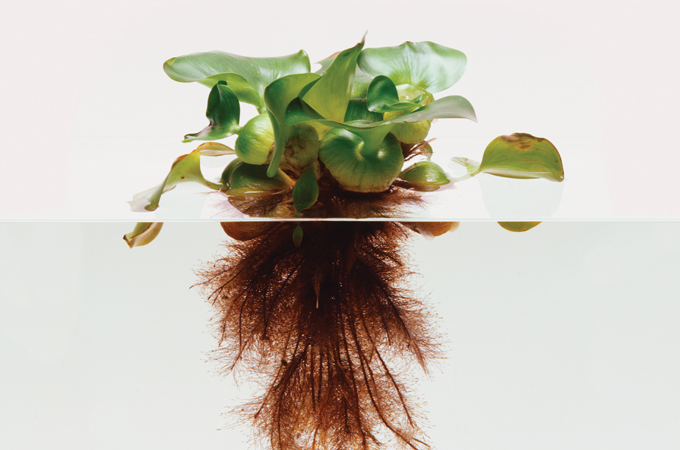
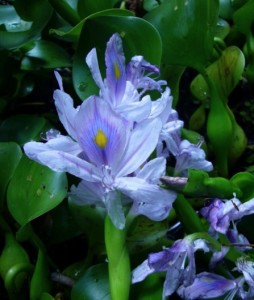
The Water Hyacinth is blooming and no doubt many people are irritated by that. The ambitious aquatic is an extremely invasive species that is hated by native plant advocates and burns up millions of tax dollars fighting it. That it is pretty and edible tends to get lost in the botanical donnybrook. The misguided fellow who intentionally introduced it into Florida around 1876 thought it so attractive he said the state should reward him. A century and half later they would throw him in jail. Closely related to the rooting Pickerel Weed, the Water Hyacinth is quite nutritious though always al dente even after much cooking. I like to chop boiled, cooled leaves tossing them in salads for added texture and flavor. When I’m cooking a soup or stew that might wilt lesser greens I use Water Hyacinth. I cook the bulbous bottoms like pork rinds whose flavor they resemble. The gold-spotted blossom also reminds me of the light British comedy “Keeping Up Appearances.” In that series four sisters are named after flowers: The vivacious Rose, the sweet Daisy, the seldom seen Violet, and problematic Hyacinth. To read more about this dreaded import go here.
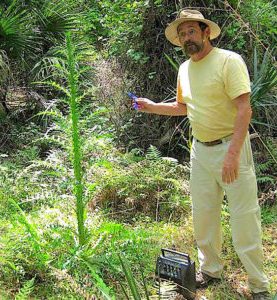
My foraging classes this week are in Largo, north of St. Petersburg, and at Ft. Meade (that is Ft. Meade in the middle of the state, not Mead Gardens in Winter Park.) The location in Largo, Eagle Lake Park, used to be a working farm so there is a lot of variety there. Ft. Meade Outdoor Recreation Area is near the beginning of the Peace River with landscape ranging from high and dry oaks with chanterelles mushrooms to damp water hickories and lots of mosquitos. All classes are about three hours long, usually over before daily showers, and include about two miles of strolling.
Saturday August 17th, Eagle Park Lake, 1800 Keene Road, Largo, FL 33771. 9 a.m. to noon. Meet at the pavilion near the dog park.
Sunday August 18th, Ft. Meade Outdoor Recreation Area, 1639 Frostproof Highway, Fort Meade, FL 33841. (Frostproof Highway is also Route 98.) 9 a.m to noon. Meet at the bathrooms in the middle of the park which is due south from the highway and not near the entrance.
Saturday, August 24th, Bayshore Live Oak Park, Bayshore Drive. Port Charlotte. 9 a.m. to noon. Meet at the parking lot at the intersection of Bayshore Road and Ganyard Street. 9 a.m. to noon.
Sunday, August 25th, Blanchard Park, 10501 Jay Blanchard Trail, Orlando, FL 32817. 9 a.m. to noon. Meet next to the tennis courts by the YMCA building.
Saturday August 31st, Wekiva State Park, 1800 Wekiwa Circle, Apopka, Florida 32712. 9 a.m. to noon. Arrive very early as there will be a lot of people wanting to go to the springs at 8 a.m. to swim. There is a park admission Fee: $6 per vehicle. Limit 8 people per vehicle, $4 for a single occupant vehicle, $2 pedestrians or bicyclists. Meet at the Sand Lake parking lot (road on left after entrance. Go to end of road.) Unlike city parks or the urban area, Wekiva Park is “wild” Florida. There are very few weeds of urbanization. The edibles are mostly native plants and far between. There is a lot of walking in this class. After class you can swim in the spring.
Sunday September 1st, George LeStrange Preserve, 4911 Ralls Road, Fort Pierce, FL, 34981. 9 a.m. to noon. The preserve has no official bathroom or drinking water so take advantage of the various eateries and gas stations before arrival.
Saturday September 7th, 329 N. Park Avenue, Winter Park. 9 a.m. to noon. Parking is free in the parking garage behind Panera’s. This is a class specializing in finding wild edibles in an urban setting.
Sunday September 8th, Ft. Desoto Park, 3500 Pinellas Bayway S. St. Petersburg Fl 33715. Meet by the bathrooms at the parking lot of the “bay” fishing pier (not the “gulf” fishing pier.) 9 a.m. to noon. There is a fee to get into the park. The fishing pier is about halfway along the SW/NE road along the southern end of the park.
Saturday, September 14th, Wickham Park: 2500 Parkway Drive, Melbourne, FL 32935-2335. 9 a.m. to noon.Meet at the “dog park” inside the park.
October 11-12-13, foraging classes at Putney Farm, Honea Path, South Carolina.
For more information, to sign up for a class, or to pay for a class go here.
Most of them don’t have common names but our local Milk Caps Mushrooms are fairly easy to identify. Think of them like well-known cartoon characters: Peachy, Bluey, Smelly, Wrinkly, Whitey, Yellowy and Peppery.
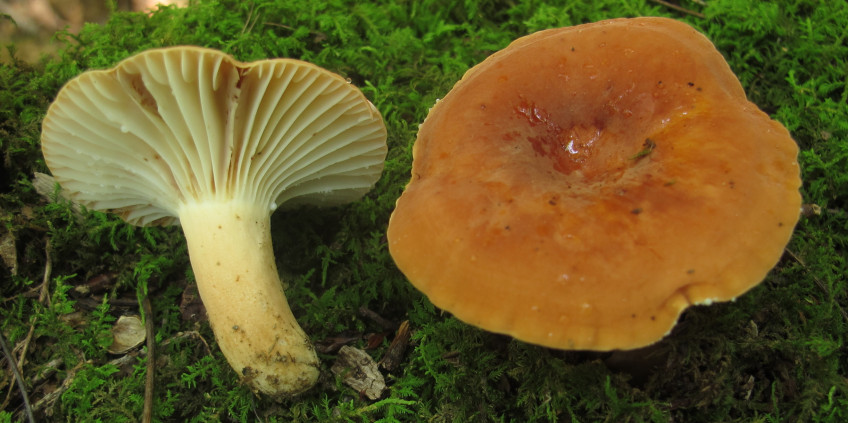
Peachy, Lactifluus hygrophorides, is indeed peach-colored on top, light golden tan underneath, has widely-spaced gills and weeps a white liquid when cut or damaged (probably to dissuade predation by bugs and other small creatures.) I suggest its common name should be Peaches & Cream. It is not peppery and quite edible with a distinctive texture. To me the flavor has a hint of maple Syrup. They fry and roast well.
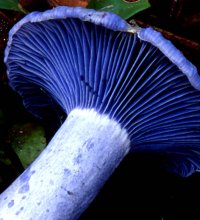
Bluey, Lactarius indigo, is self-explanatory: It weeps a blue liquid when cut or damaged. While edible it can be a bit granular in texture but is among the most beautiful of edible mushrooms you will find. Perhaps like many flashy things the flavor of this Milk Cap does not reach the same heights as it coloring. But, it is still an edible and I happily take it home with me. (And did you notice the shift in the genus name? They all used to be Lactarius but now some are Lactifluus.)
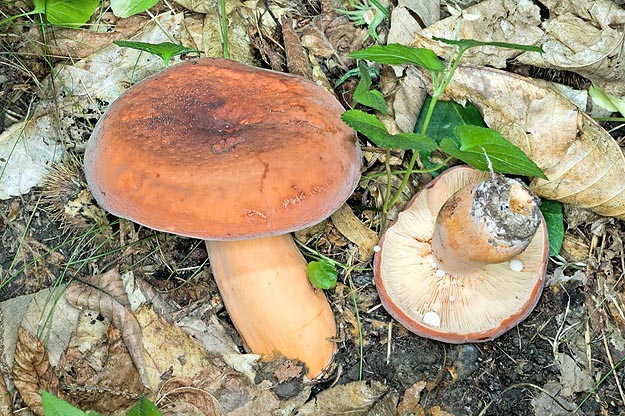
Smelly, Lactifluus volemus, is a bit more complex and if it had a second name it would be Smelly Brownie. It is so… distinctive… unlike its kin it actually has several common names including Bradley, Tawny Lactarius, Apricot Milk Cap, Leatherback, and Fishy Milky. The common name “Bradley” which is found mostly in the West Virginia area, is a corruption of “Bratling” German for a mushroom used for roasting or boiling. Incidentally its scientific name is no help at all: It means “pear filling the palm of your hand.” “Volemus” might be a Dead Latin stand-in for “voluminous” a reference to all the liquid it loses.) Smelly is an attractive mushroom with brownish orange colors… tawny. It, too, has a white liquid but it quickly stains everything brown… itself, your hands, your mushroom knife, your mushroom basket, your clothes, everyone it or you touch. And it often also develops a definite fishy order than can increase greatly over time after it has been picked. Cooked it has no fishy taste or flavor. It’s good eating. The cap is smooth but can wrinkle a little as it ages which brings us to Wrinkly, Lactarius corrugis.
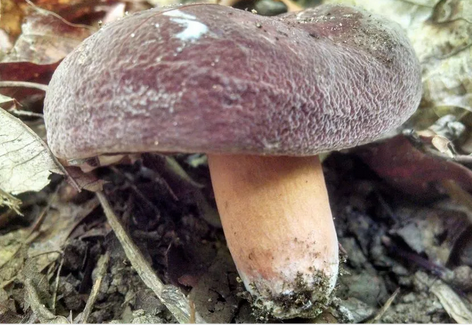
No doubt you have heard of corrugated cardboard or corrugated roofing. Wrinkly tends to be a large mushroom with a wrinkly, sometimes purplish cap. If it had a second name it would be Wrinkly Fuzzy. It almost appears to be covered with a whitish to grayish felt when young but like the rest of us gets wrinkly as it ages. Like Smelly the fluid Wrinkly leaks will stain the mushroom brown over time but not you, an important difference between it an Smelly.
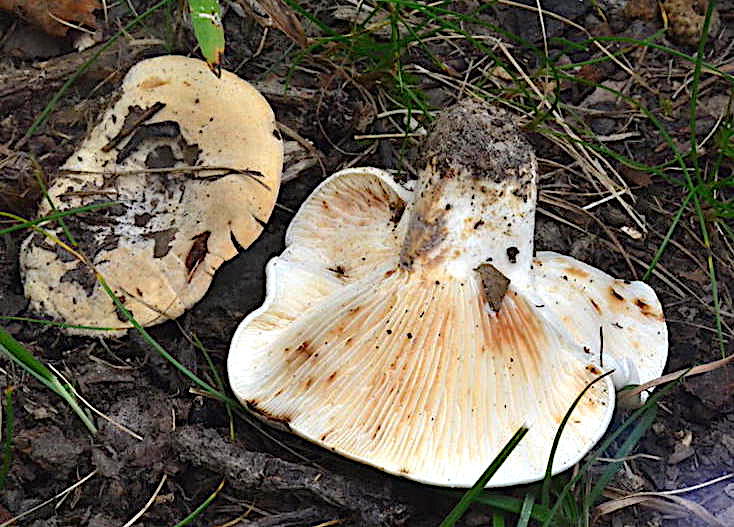
And now we get to two Milky Mushrooms that are edible but have close relatives that look similar but are too peppery to eat. Whitey, Lactifluus luteolus, also stains itself brown and can have a fishy odor like Volemus. One of the problems with this mushroom is it usually has leaves stuck to its cap making it difficult to clean. If you can find a leafless one they cook up well and have a good taste. A non-edible Milk Cap that looks similar is Lactarius glaucescens. However, Lactarius glaucescens‘ gills are extremely tightly packed, the liquid it weeps dries to a light olive color over time, and if you taste the flesh or liquid it will intensely burn hole in your tongue.
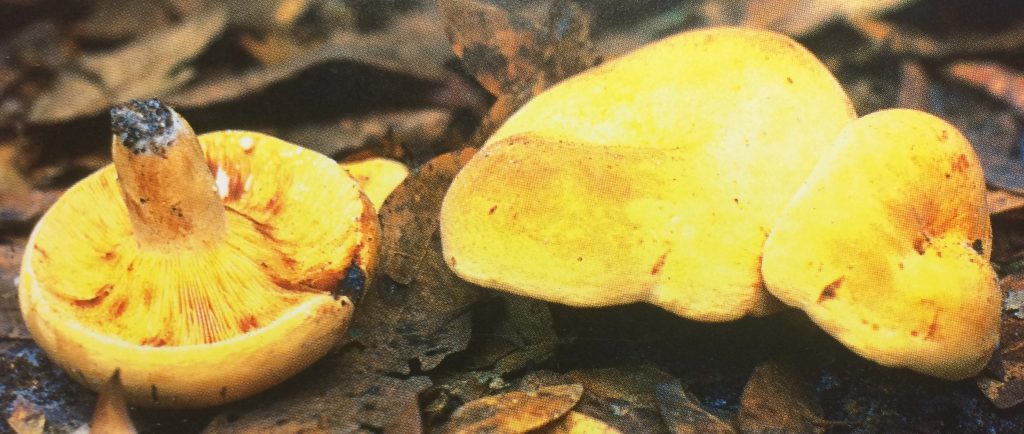
Our last edible one, Yellowy, is easy and difficult to explain. It is a light tan and large version of Smelly, Lactifluus volemus. And like the other edible Milk Caps it is not peppery. I have seen it several times. It really is a yellowy-tan bigger version than Smelly and with wavy edges. James Kimbrough, who wrote Common Mushrooms of Florida called it Lactarius volemus var. flavus but the name does not appear to have caught on and it should also now be Lactifluus. And… there is a similar large, light tan Milk Cap — prehaps Lactarius psammicola or variation– that grows in the same place at the same time and kind of looks like the Flavus. It has concentric rings on top, is often wavy, but that Milk Cap will burn a hole in your tongue. The Flavus does not. What happens to me is I see what I think is the Flavus and taste it but it is the Psammicola… you can take only so many holes burned through your tongue at one time.
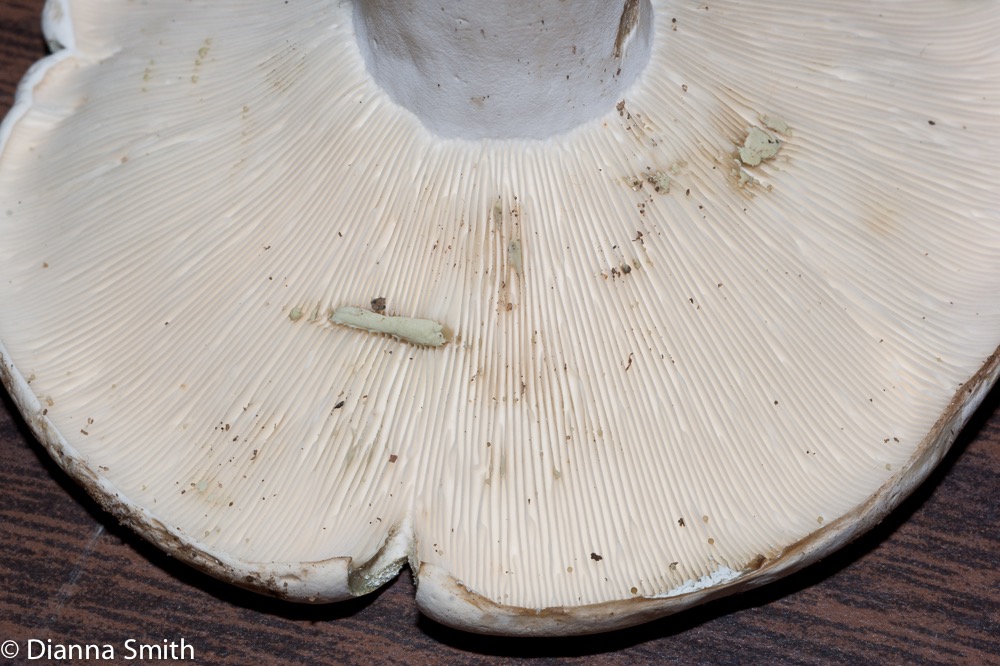
If the mushroom is leaking a fluid — milky, clear turning milky or brown — or blue — when you break the gills or stem you’ve probably got a Milk Cap. And if that leaking mushroom is not peppery tasting it is usually edible. If it is peppery it is too acrid to eat though none of them are life-threateningly toxic. Do note that in some places peppery Milk Caps are either dried for use as a spice — hard to imagine — or lacto-fermented to make them edible.
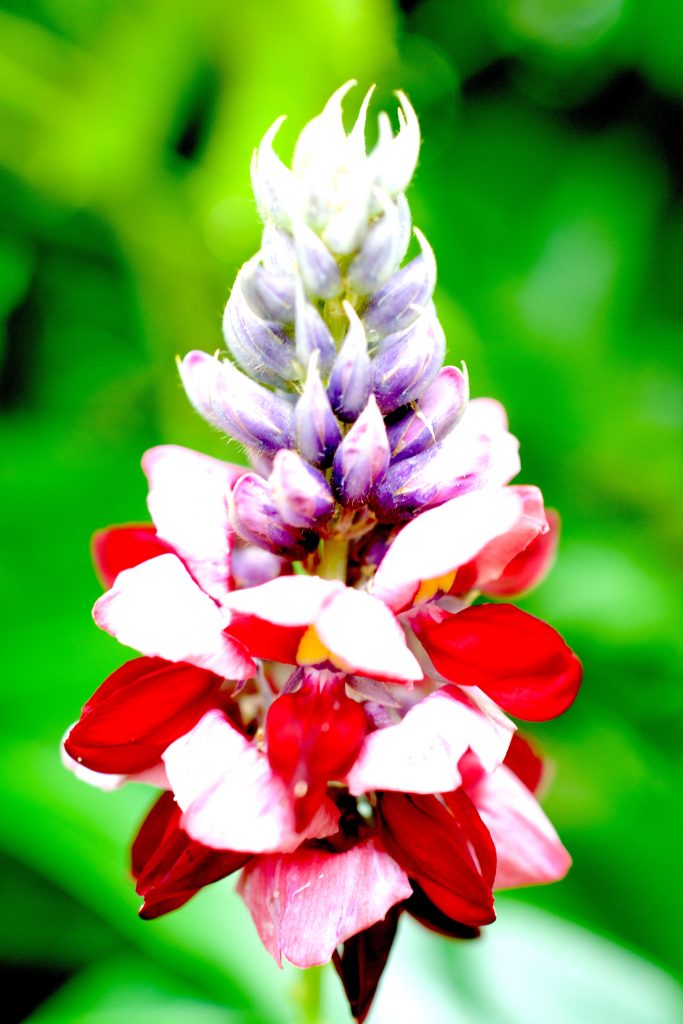
While foraging this week I saw a plant that is commonly known to have smothered The South: Kudzu. It grows so fast that it leaves one with the impression that if you fell asleep in a lawn chair at noon by supper time you would be covered by it. Kudzu can grow a yard a day. It’s sporadic here in central Florida but driving or hiking through places like North or South Carolina one can see steep hillsides thickly blanked with the large, herbaceous vine. There are actually several species that are more invasive than Kudzu and it might not be the botanical beast news reports make it out to be. Important to us is that nearly the entire plant is edible: Leaves, growing tips, grape-scented blossoms, young roots whole and starch from older roots. Only the seeds are not edible by humans. The plant does support wild life and domestically goats are particularly fond of it. Turning Kudzu into goat products is profitable, tasty and sustainable. While Kudzu can be a local problem its invasiveness has been exaggerated by regional writers.
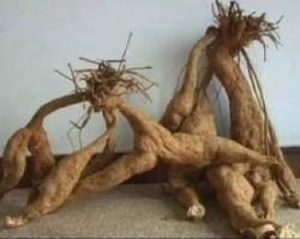
Kudzu was first championed during the Dust Bowl Era because it was the prime plant for fighting erosion. Folks were paid to sow it on their land (no complaining then.) About a million acres were planted over the next 20 years then the program ended. Kudzu meanwhile had worked its way into southern novels and folksy observations. It became a southern cliche. In reality Kudzu occupies about one tenth of one percent of the South’s 200 million acres of forest, or 227,000 acres. Asian Privet, which is rarely commented on by anyone, occupies some 3.2 million acres, 14 times that of Kudzu. Kudzu is spreading but at one thousandth the rate of the Asian Privet, around 2,500 acres a year. And in time Kudzu might be significantly reduced: A decade ago a Japanese Kudzu bug was found in a garden in Atlanta (a city which is six times the size of the Kudzu infestation.) The bug was a stowaway on some plane. It is now successfully devouring Kudzu. In one test site the bug ate a third of the Kudzu in two years. In years to come Kudzu might be but a bucolic memory, a quaint reference to how it used to be in sleepy little souther towns. To read more about Kudzu, go here.
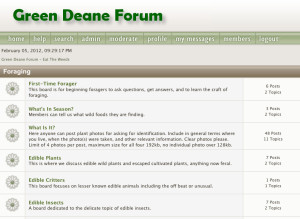
Want to identify a plant? Perhaps you’re looking for a foraging reference? You might have a UFO, an Unidentified Flowering Object you want identified. On the Green Deane Forum we — including Green Deane and some 8,000 others from around the world — chat about foraging all year. And it’s not just about warm-weather plants or just North American flora. Many nations share common weeds so there’s a lot to talk about. There’s also more than weeds. The reference section has information for foraging around the world. There are also articles on food preservation, and forgotten skills from making bows to fermenting food.

All My Videos are available for free on You Tube. They do have ads on them so every time you watch a Green Deane video I get a quarter of one cent. Four views, one cent. Not exactly a large money-maker but it helps pays for this newsletter. If you want to see the videos without ads and some in slightly better quality you can order the DVD set. It is nine DVDs with 15 videos on each for a total of 135 videos. Many people want their own copy of the videos or they have a slow service and its easier to order then to watch them on-line. The DVDs make a good gift for that forager you know especially as spring is … springing. Individual DVDs can also be ordered or you can pick and choose. You can order them by clicking on the button on the top right hand side of this page (if your window is open wide enough.) Or you can go here.

Donations to upgrade EatTheWeeds.com and fund a book have gone well. Thank you to all who have contributed to either via the Go Fund Me link, the PayPal donation link or by writing to Green Deane POB 941793 Maitland FL, 32794. There are several in-the-way items that needs to be fixed such as expanding the Foraging Instructor page. At the moment it won’t add any more entries. See the webmaster notice below.
This is weekly newsletter 368. You can sign up for this free newsletter by clicking on menu (or find in the command line) Newsletter Sign-up. These newsletters — like all my articles on the website — are written by me. There is no cut and paste… Every misspelling is mine and totally mine.
I am in the need for a part-time webmaster who knows WordPress and who would like to exchange web work for foraging classes. The job would consist up upgrading or resolving some current issues — mostly minor – to solving future issues as they arise. You can also assign the classes to someone else if you have webmaster skills but someone you know likes foraging.

